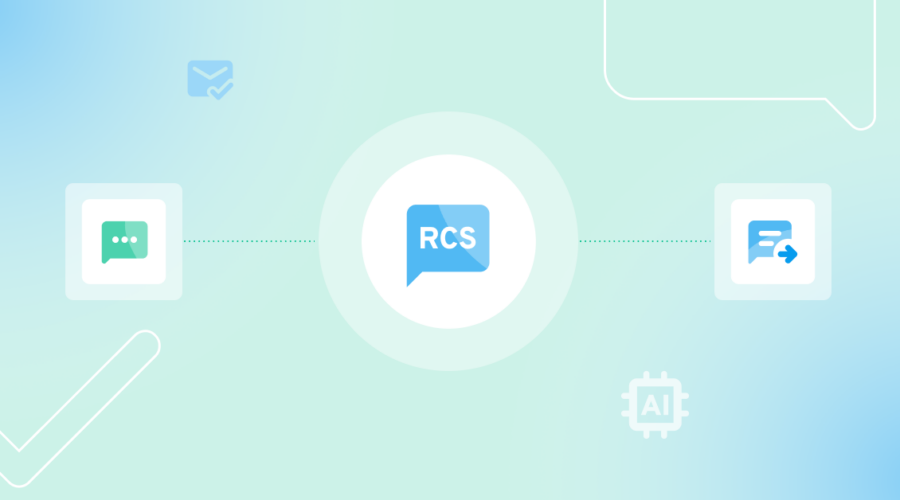RCS (Rich Communication Services)
What does RCS messaging mean?
RCS messaging stands for Rich Communication Services, and is a communication protocol that lets users send messages with rich multimedia experiences and advanced functionality.
RCS messaging is the future of texting by taking the very best features of the messaging services you know and love—SMS, MMS, iMessage, Facebook Messenger, and WhatsApp—to create a new standard that delivers those services within a single experience you can use on your existing mobile client.
Why is RCS messaging gaining popularity?
Services like iMessage and Facebook Messenger have changed how we think about messaging. Users no longer just want to send text, they want an immersive messaging experience. RCS messaging gives them that.
RCS chat features including real-time feedback like read receipts and typing notifications let you know when your message has been looked at and when you’re about to get a response. Rich dynamic content such as video, images, and links can all be added with RC messaging, creating a more engaging, branded experience. Quick response buttons create a fast, error-free way for your customers to respond to specific situations.
A history of RCS messaging
To learn the history of RCS messaging, we must go back to the birth of SMS, way back in 1982. The original idea behind SMS was to send texts via the same signaling system that controlled telephone traffic (it took nearly a decade of work!). And in December of 1992, Neil Papworth texted “Merry Christmas” to a customer with the first-ever SMS message.
By 2010, 6.1 trillion messages were being exchanged by cellular devices. Cut to 2022–15 million texts are sent every minute. The rise in SMS also led to the birth of apps like WhatsApp, Line, and Facebook Messenger–apps that only continued to grow in popularity as they gained over 1.2 billion users.
Despite this, SMS hasn’t changed all that much, never evolving beyond its 160-character limits. That’s when the idea of RCS messaging came about–it was time for a change.
RCS vs. SMS messaging
So how does RCS messaging relate to other messaging formats? Let’s find out!
SMS (Short Message Service) is the most commonly used form of texting, and best of all, you don’t need mobile data or WiFi to send or receive them!
RCS messaging, on the other hand, is a combination of SMS and MMS capabilities available via Android.
RCS vs. MMS messaging
MMS (Multimedia Messaging Service), as the name implies, allows you to send multimedia formats over text like video, audio, GIFs, and images.
RCS messaging includes capabilities to send media, but also plain text—so you don’t need to choose one or the other.
Unlike MMS and SMS, RCS messaging is exclusive to improving the Android messaging experience.
How to use RCS messaging
If you’re using Android Messages to text your friends and family, you can use RCS chat.
Google and Samsung partnered together so that RCS works seamlessly on both Android Message apps and Samsung Messages.
RCS is not universally supported. You might not be able to use it if you own a non-Android device like an iPhone.
If you already have an Android, you can activate RCS messaging by:
- Download Google’s Messages app if you don’t already have it.
- Open the app and select the three-dot menu in the top-right.
- Go to settings, then General.
- Once under General, select Chat features.
- If Chat is something your device can use, you’ll be able to tap a slider and select “Yes, I’m in” from a popup.
- Now, all you have to do is verify your number, and you’ve got RCS!
Now you can check read receipts and see if your friends are typing messages.
What are the benefits of RCS messaging?
As an alternative to SMS and MMS, and bringing over many features you’d typically get with OTT messages, like read receipts, RCS messaging has many perks.
A new standard for interoperability
It’s easy to forget that messaging is a little fractured. You have SMS for text messages, but as soon as you want to add something else (image, video, links, etc), you’re sending an MMS. Want to send that funny cat GIF outside the U.S.? You’re going to run into problems.
RCS messaging creates a unified standard for sending messages of all types, wherever you want to send them.
Unified branding across channels
For businesses, the ability to create a branded experience, with colors, logos, and images, reaffirms the brand experience for your customers. RCS messaging makes that possible, allowing you to create messages that align with your look and feel, creating a unified brand experience across all of your channels.
Building customer trust
Another perk: the chance to build trust as a verified sender with a logo for instant brand recognition. Early experiments show that RCS and SMS can play well together as a part of a multi-channel strategy.
That sweet, sweet data
Before RCS, your measure of SMS success stopped at the delivery receipt level (and even then, you may only get so far as a carrier handoff receipt—not a device receipt). This changes with RCS messaging. Read receipts, click-through rates, and other more traditional marketing measurements will be at your fingertips. With a better understanding of what messages resonated (and which didn’t), you can better tailor your marketing efforts.
What are the most important features of RCS messaging?
The RCS features businesses are excited to implement
Verified sender branding – no numbers!
Messages will appear under your brand’s verified name instead of a phone number customers don’t recognize.
Rich media
You can send visually appealing cards with business information, carousels featuring photos and item details, and even large files like videos. (Think MMS but with even more multimedia capability!)
Two-way communication
Make customer conversations flow more smoothly with typing indicators, read receipts, and even suggested replies and actions.
Ways to use RCS in Application-to-Person Messaging
- Real-Time Feedback. Get in-the-moment feedback on how customers are engaging with your messages. You can use RCS to read and received receipts, know when a customer is typing, or monitor clicked links.
- Rich Content. Include images, videos, and links without having to transcode your messages.
- Quick Responses. Suggest actions to create a quick, easy customer experience. Whether it’s changing seats or upgrading their room, interactions can be a button push away.
- App-like Features. Link to apps such as Calendar, Maps, or the Dialer. Or, embed important metadata such as telephone numbers, location data, and event details, creating a seamless customer experience.
Who supports RCS messaging?
Because RCS is a newer protocol, it is not yet supported by all device manufacturers or all carriers.
There are around 60 supporters. This number is split between mobile operators, OEMs, and OS providers. Carriers like T-Mobile were eager to add RCS messaging, but some were wary of the software and network updates required. That’s why Google services RCS messages via an app so they don’t have to count on carrier support.
Apple announced in late 2023 that they’d be opening up support for RCS in 2024, a big milestone in the expansion of RCS.
The future of RCS
More and more business markets are starting to include RCS messaging to better engage their customers. This kind of messaging is a way to stand out from competitors and keep customers engaged. Learn more about the future of messaging here.
RCS messaging FAQs
What is the difference between RCS and RBM?
RCS is a set of user stories that messaging clients (like Android and Apple) must support to enable RCS P2P (peer-to-peer) messaging. RBM, on the other hand, stands for Rich Business Messaging, and means a set of APIs that companies like Bandwidth must build to support RCS A2P (application-to-person) messaging.
Is RCS messaging only supported on Android devices?
In June 2024, Apple announced it will support RCS messaging, which opens a new world of potential use cases and viability for the protocol.
Is RCS messaging free?
Brands will have to pay to send RCS messages to their customers, just as they currently pay to send SMS and MMS messages.



